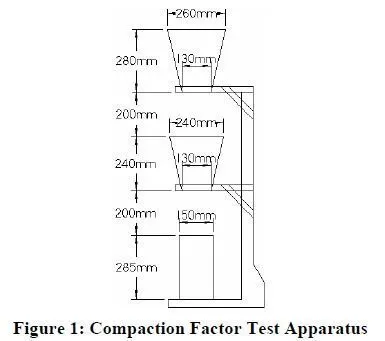The slump test is the most well-known and widely used test method to characterize the
workability of fresh concrete. The inexpensive test, which measures consistency, is used on job sites to determine rapidly whether a concrete batch should be accepted or rejected. The test method is widely standardized throughout the world, including in ASTM C143 in the United States and EN 12350-2 in Europe.
The apparatus consists of a mold in the shape of a frustum of a cone with a base diameter of 8 inches, a top diameter of 4 inches, and a height of 12 inches. The mold is filled with concrete in three layers of equal volume. Each layer is compacted with 25 strokes of a tamping rod. The slump cone mold is lifted vertically upward and the change in height of the concrete is measured.
Four types of slumps are commonly encountered, as shown in Figure 3. The only type of slump permissible under ASTM C143 is frequently referred to as the true slump, where the concrete remains intact and retains a symmetric shape. A zero slump and a collapsed slump are both outside the range of workability that can be measured with the slump test. Specifically, ASTM C143 advises caution in interpreting test results less than ½ inch and greater than 9 inches. If part of the concrete shears from the mass, the test must be repeated with a different sample of concrete. A concrete that exhibits a shear slump in a second test is not sufficiently cohesive and should be rejected.The slump test is not considered applicable for concretes with a maximum coarse aggregate size
greater than 1.5 inches. For concrete with aggregate greater than 1.5 inches in size, such larger particles can be removed by wet sieving.
Additional qualitative information on the mobility of fresh concrete can be obtained after reading the slump measurement. Concretes with the same slump can exhibit different behavior when tapped with a tamping rod. A harsh concrete with few fines will tend to fall apart when tapped and be appropriate only for applications such as pavements or mass concrete. Alternatively, the concrete may be very cohesive when tapped, and thus be suitable for difficult placement conditions.

Slump is influenced by both yield stress and plastic viscosity; however, for most cases the effect of plastic viscosity on slump is negligible. Equations have been developed for calculating yield stress in terms of slump, based on either analytical or experimental analyses. Since different rheometers measure different absolute values for the yield stress of identical samples of concrete, the experimental equations are largely depended on the specific device used to measure yield stress.
Based on a finite element model of a slump test, Hu et al. (1996) developed an expression for yield stress in terms of slump and density, as shown in Equation [1]. The finite element calculations were performed for concretes with slumps ranging from zero to 25 cm. The
equation is not appropriate for concretes with a plastic viscosity greater than 300 Pa.s, above which viscosity sufficiently slows flow and causes thixotropy, resulting in a reduction of the actual slump value. An experimental study to verify the results of the finite element model showed satisfactory agreement between Equation [1] and yield stress measurements from the BTRHEOM rheometer. It should be noted that the finite element calculations were preformed for concrete with slumps as low as zero, while the BTRHEOM rheometer can only measure
concretes with slumps greater than approximately 10 cm.

Using a viscoplastic finite element model, Tanigawa and Mori (1989) developed threedimensional graphs relating slump, yield stress, and plastic viscosity for concretes with slumps ranging from 1 to 26 cm. Schowalter and Christensen (1998) developed a simple analytical equation to relate slump to yield stress and the height of the unyielded region of the slump cone, defined as the region where the weight of concrete above a given point is insufficient to overcome the yield stress. Other, more complex analytical analyses have been developed.
Additionally, Tattersall and Banfill (1983) have presented experimental data showing a
relationship between slump and yield stress.
Advantages:
The slump test is the most widely used device worldwide. In fact, the test is so well known that often the terms workability and slump are used interchangeably, even though
they have different meanings.
Specifications are typically written in terms of slump.
The slump test is simple, rugged, and inexpensive to perform. Results are obtained
immediately.
The results of the slump test can be converted to yield stress in fundamental units based on various analytical treatments and experimental studies of the slump test.
Compared to other commonly used concrete tests, such as for air content and
compressive strength, the slump test provides acceptable precision.
Disadvantages:
The slump test does not give an indication of plastic viscosity.
The slump test is a static, not dynamic, test; therefore, results are influenced by concrete thixotropy. The test does not provide an indication of the ease with which concrete can be moved under dynamic placing conditions, such as vibration.
The slump test is less relevant for newer advanced concrete mixes than for more
conventional mixes.
